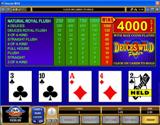
Winner's Guide Volume 3: Full Pay Deuces Wild
Learning to Walk Before You Run
 Bob Dancer is one of the world's foremost video poker experts. He is a regular columnist for Casino Player, Strictly Slots, and the Las Vegas Review-Journa land has written an autobiography and a novel about gambling. He provides advice for tens of thousands of casino enthusiasts looking to play video poker. Bob's website is www.bobdancer.com rather than video poker players, but many gamblers seeking an edge play more than one game.
Bob Dancer is one of the world's foremost video poker experts. He is a regular columnist for Casino Player, Strictly Slots, and the Las Vegas Review-Journa land has written an autobiography and a novel about gambling. He provides advice for tens of thousands of casino enthusiasts looking to play video poker. Bob's website is www.bobdancer.com rather than video poker players, but many gamblers seeking an edge play more than one game.
They each had Dancer / Daily strategy cards for the game and were looking up hands regularly. They were using the Level 4 (Advanced) strategy because, well, they were professional gamblers and smart. But they were getting all confused because they didn't have the earlier strategies memorized.
On a hand such that contains an inside straight and a 2-card King high royal, such as Kh Jh Ts 9d 3h, Level 2 (Recreational) and Level 3 (Basic) both clearly say that the 4-card inside straight is preferable. And it is, as a general rule. On the hand in question, on the $5 machines that were being played at this casino, holding KJT9 is almost 50¢ more valuable than holding KJ.
The Level 4 strategy lists the cases where 2-card King-high is actually superior to an inside straight, such as on a hand like Kc Tc 8d 7s 6h where holding KT is the better play by 18¢. The card talks about the specific combinations (J987 or Ten-high) and required absence of any of the lower three cards being suited with the king.
The problem for these two players is that they were STARTING with Level 4 without having the earlier strategy committed to memory. So every time they got a 2-card king-high royal and an inside straight, they spent 30 seconds or so finding the correct place on the strategy card and figuring it out anew. And there were literally dozens of other hands they were looking up as well; getting frustrated because the strategy they were looking at described straight penalties, flush penalties, ³at the extreme² penalties, and sometimes two or more penalties in the same hand.
After about an hour of this while I was there (and I'm not sure how long before), they got tired of looking up hands. They started holding all 2-card royals over an inside straight, which is a big error when there is a king involved. They kept the Level 4 strategy in their pocket simply because it was too tedious for them.
Had these two players been using a lower-level strategy, available on the same card, they'd probably already have the general rule memorized. After all, it's not that hard. It's only difficult when you are trying to master every exception at the same time you're learning the basics. So going to Level 4 before they were ready was ending up COSTING THEM MONEY, simply because they found it too difficult to be useful.
There are many strategy card designers (who do not include a Level 4 on their strategies) who point to an example like this and use it as evidence that a perfectly accurate strategy is simply too difficult for players to master. To people who argue this, I say this conclusion is nonsense.
These same two players have played 10/7 Double Bonus for a few years. On this game, which is considerably more difficult for most people than NSU Deuces Wild, they have the basic strategy down cold. Now when a potential penalty card situation comes up, like whether you hold the hearts or the clubs from Kh Jh Tc 8c 7c and Kh Qh Tc 8c 7c (answer: clubs in the first hand, hearts in the second), these players zero in on the correct place on the strategy card (because they've used it so many times), refresh themselves quickly, and make the correct play. They turn to the strategy card two or three times an hour and find it very useful.
The key here, I think, is when you move up to the advanced strategy. If you do it first thing because you're a pretty bright person and you're good at some other game, then Level 4 will probably end up confusing you. If you move up after using the lower strategies for several dozen hours or more, then you'll find Level 4 attainable.
It's a matter of learning to walk before you run, and each new game requires new practice in walking.

